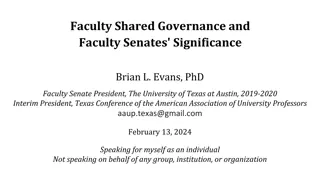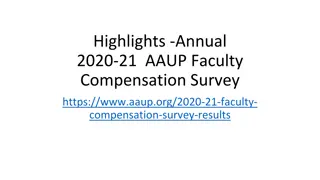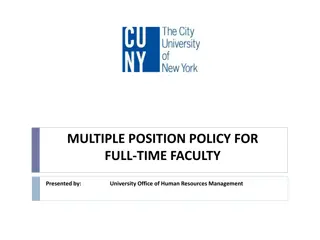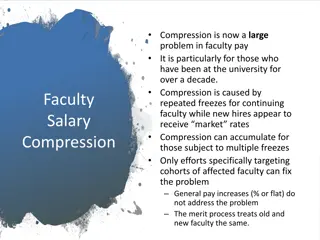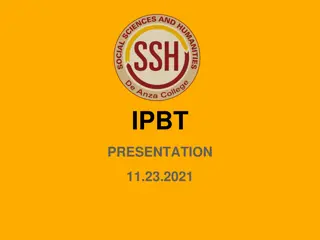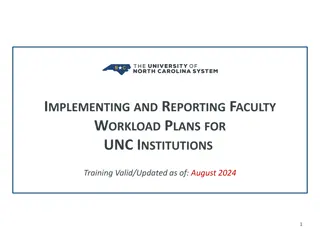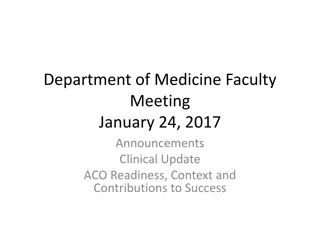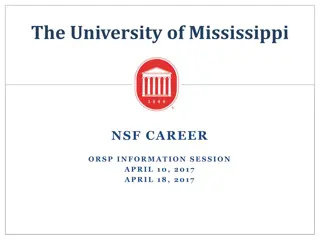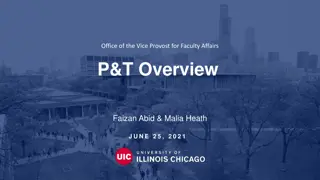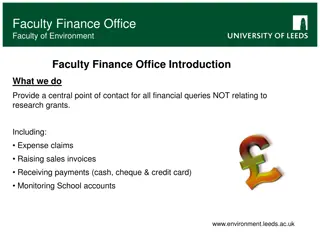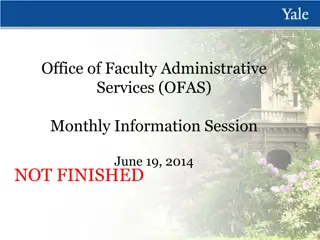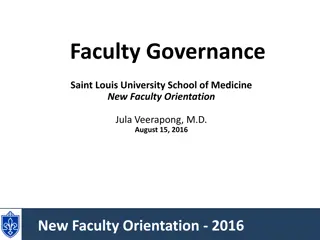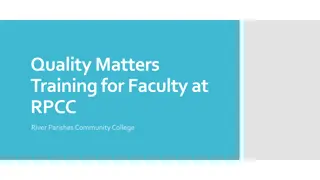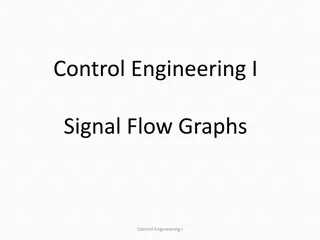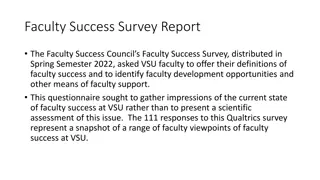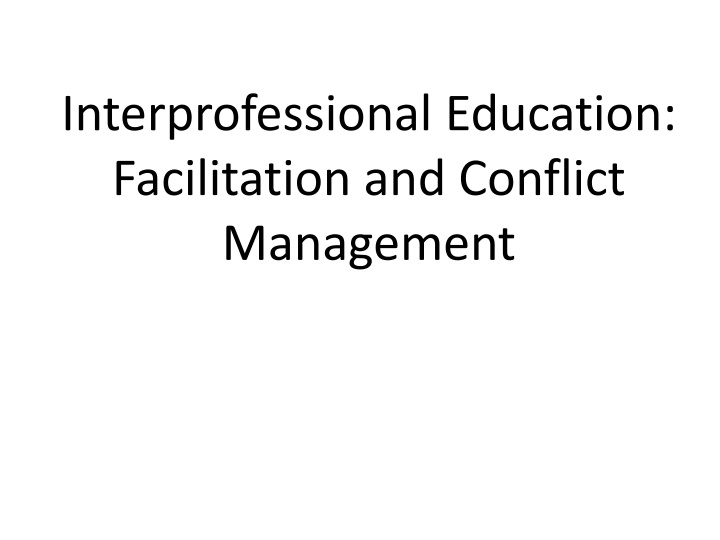
Effective Strategies for Interprofessional Education Facilitation and Conflict Management
Discover the goals and outcomes of Interprofessional Education sessions, explore the roles of faculty and students, and learn about effective facilitation techniques and conflict resolution in healthcare teams.
Download Presentation

Please find below an Image/Link to download the presentation.
The content on the website is provided AS IS for your information and personal use only. It may not be sold, licensed, or shared on other websites without obtaining consent from the author. If you encounter any issues during the download, it is possible that the publisher has removed the file from their server.
You are allowed to download the files provided on this website for personal or commercial use, subject to the condition that they are used lawfully. All files are the property of their respective owners.
The content on the website is provided AS IS for your information and personal use only. It may not be sold, licensed, or shared on other websites without obtaining consent from the author.
E N D
Presentation Transcript
Interprofessional Education: Facilitation and Conflict Management
Goals of IPE Session for Student Trainees Recognize one another s roles in healthcare Learn team-building and collaborative roles in the context of a patient case Identify characteristics of functional teams Review strategies for team-building and conflict resolution
IPE Faculty Roles Recognize one another s professional roles Collaborate to achieve trainee learning objectives Facilitate small group (team-based) case discussion and decision-making Give feedback to your teams Summarize and reflect on learning
Todays Learning Objectives By the end of session, you will: Recognize one another s professional roles Identify characteristics of functional teams Identify characteristics of effective IPE facilitation Roleplay facilitation of role recognition among learners
Learning Objective 1: Identify characteristics of effective IPE facilitation As you watch this video, identify the characteristics of effective and ineffective IPE facilitation. What was done well in facilitation? What could be improved, and how? What are consequences of poor facilitation? Consider how you might improve your own IPE facilitation style.
Facilitator Roles Directing/Forming: set climate, clarify roles and goals, build group identity Coaching/Storming: legitimize concerns, invite feedback, accept and expect tension Norming/Performing: offer resource, share leadership, consult and coach (1 on 1) Delegating/Separating: adjust style, let go, anticipate termination
Learning Objective 2: Facilitate role recognition among learners Watch the video and Consider what would you do as a facilitator
Pitfalls in Facilitating Role Recognition Usual Facilitation IPE Facilitation Pitfall Solution/Remedy/ Prevention
Role Recognition Sets climate for team work Gives equal voice to every team member Corrects misperceptions or assumptions Opens learning conversation for cross- fertilization Establishes common vocabulary for learning Anticipates future conflicts
Team Dynamics and Conflict Consider power dynamics and hierarchy Were ground rules established? Is diversity strength or hindrance? What are underlying assumptions? (gender, status, seniority, age, education) What is antecedent for decision-making?
Managing Potential Conflict Proactive Observe team behavior Use tools (e.g., MBTI) Establish trust early (e.g., personal histories) Reactive Acknowledge potential conflict Facilitate problem-solving: respect, support, process Team effectiveness exercise Member strength/weakness exercise 1. Zwarenstein M, et al. Cochrane Database Syst Rev. 2009;(3):CD000072. 2. Reeves S, et al. Cochrane Database Syst Rev. 2008;(1):CD002213.
Learning Objective 3: Dynamics and Processes Watch the video and observe: What team dysfunctions are apparent? What escalated conflict? Which stakeholders were affected by the process? Where dysfunction could be addressed? How might you act as a facilitator for this team?
Dynamics and Processes What team dysfunctions are apparent? What escalated conflict? Which stakeholders were affected by the process? Where dysfunction could be addressed? What would you do if you were the facilitator for this team?
Dynamics and Processes Inattention to Results Status and Ego Avoidance of Accountability Low Standards Ambiguity Lack of Commitment Artificial Harmony Fear of Conflict Invulnerability Absence of Trust *http://ipe.utoronto.ca/educators/competencies.html
Address Conflict and Dynamics Build trust Understand motivation Personal stories of origin (autobiographies) 2. Establish conflict culture (safety) Profile team and members (Thomas-Killman) Conflict norming 3. Manage meetings ( Death by meeting ) Use Lightning rounds Encourage voices
Address Conflict and Dynamics Get commitment Remove assumptions Get buy in and clarity Commitment Consensus Use cascading communication 5. Establish accountability Common thematic goals ( patient outcome ) Peer to peer communication Facilitator leadership (strength/weakness exercise) Keep scoreboard (list milestone accomplishments)
Ask for Team Assessment Reflection How did we do today as a team? What enabled/supported our collaboration? Were team members heard and respected? If not, how can we improve? Did anything interfere with ability to contribute? What else might improve our interaction? REFLECT
Provide Your Feedback to IPE Team Feedback should Start with team self-assessment Be based on direct observation Be clearly stated and prefaced Be regular Be balanced Be specific Use teach-back to ensure message is received
Faculty Exercise (Role Play) Break into groups of 6 to 8 Two will be faculty mentors, the rest will be trainees from the 3 professions (one scribe) Faculty: using the script, go through case with your trainees and facilitate case discussion using steps described After 10 to 15 minutes Scribe will list record strengths and weaknesses of the process Report findings to large group
Summary IPE involves: 1. Creation of IP teams 2. Facilitation 3. Role recognition 4. Conflict management 5. Building trust 6. Reflection


